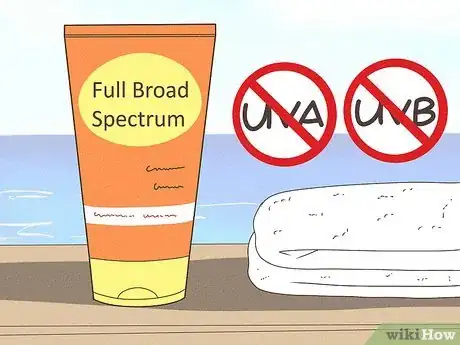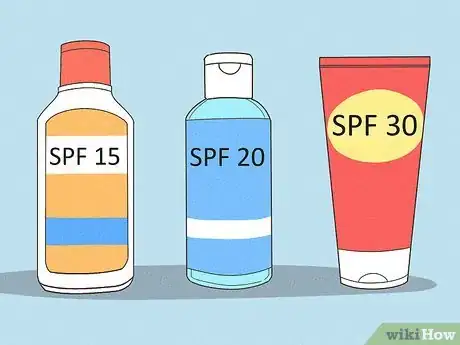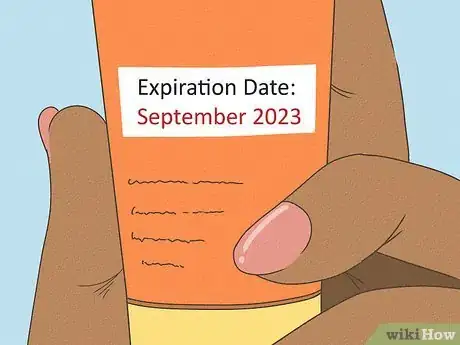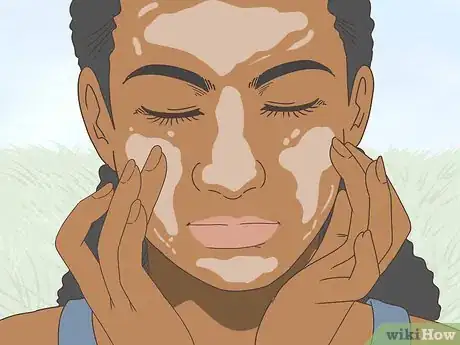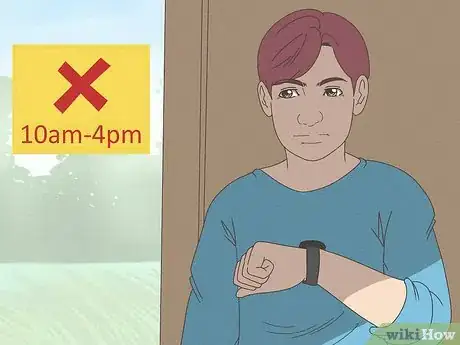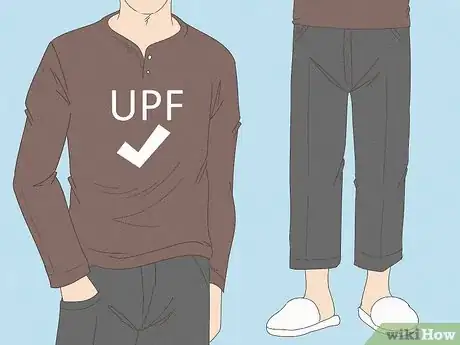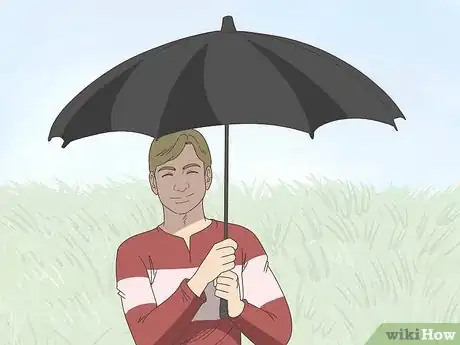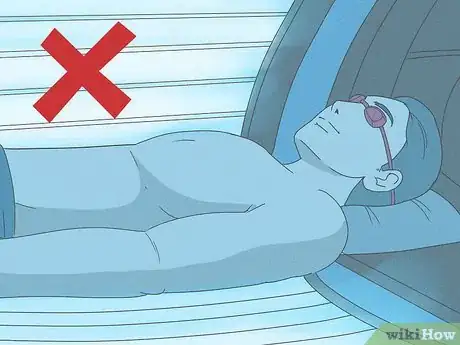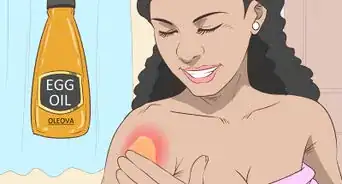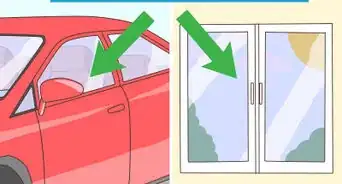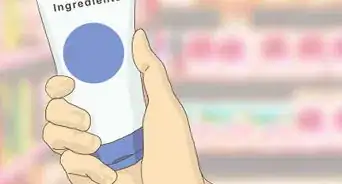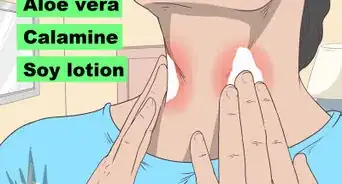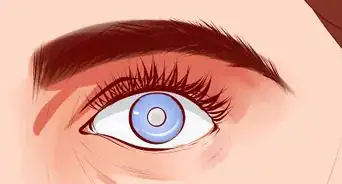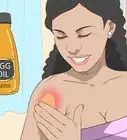This article was medically reviewed by Sarah Gehrke, RN, MS. Sarah Gehrke is a Registered Nurse and Licensed Massage Therapist in Texas. Sarah has over 10 years of experience teaching and practicing phlebotomy and intravenous (IV) therapy using physical, psychological, and emotional support. She received her Massage Therapist License from the Amarillo Massage Therapy Institute in 2008 and a M.S. in Nursing from the University of Phoenix in 2013.
There are 9 references cited in this article, which can be found at the bottom of the page.
wikiHow marks an article as reader-approved once it receives enough positive feedback. In this case, 87% of readers who voted found the article helpful, earning it our reader-approved status.
This article has been viewed 323,176 times.
Spending time outdoors in the sun can be fun, but getting a sunburn definitely isn't. It doesn't just mean temporary pain either -- a burn puts you an increased risk for skin cancer and signs of premature aging. If you want to keep your skin burn-free, it all starts with proper sunscreen application and limited sun exposure.
Steps
Using Sunscreen
-
1Choose a broad spectrum sunscreen. The sun produces 3 types of ultraviolet (UV) rays -- UVA, UVB, and UVC rays. UVB rays can burn your skin, while UVA rays cause premature aging, such as wrinkles and dark spots. Both UVA and UVB rays can increase your chances of skin cancer.[1] For the best protection, you should use a sunscreen that protects against both types of rays, so check the label to ensure that it provides full- or broad-spectrum protection.[2]
-
2Select an appropriate SPF. A sunscreen's SPF measures how well it protects your skin from UVB rays compared to not wearing it. For example, if it normally takes 20 minutes for your skin to turn red, a product with SPF 15 will typically prevent sunburn for 15 times longer. [3] You should use a product that has an SPF of at least 15.[4]
- If you’re only going to be spending a few minutes here and there in the sun, using a face moisturizer or aftershave with SPF 15 is usually sufficient to protect your skin from burning.
- If you're extremely active and plan to spend most of the day outside, a water-resistant sunscreen with a higher SPF, such as SPF 30, is a better option.
- For pale, sensitive skin that burns easily, it’s best to use a sunscreen with an SPF 50.[5]
Advertisement -
3Check the expiration date. Sunscreens become less effective as they age, so it's important to use one that's still able to protect your skin. A date is usually printed somewhere on the bottle that indicates when the sunscreen should be used by, so always check to ensure that it's still good to use.[6]
- Most sunscreens are good for approximately three years after you purchase it. Because you need to reapply regularly, you'll probably use up a tube or bottle long before it expires.
-
4Apply generously. If you don’t apply enough sunscreen, you won’t get the full benefits, and may wind up burning. For the best protection, you need 1 ounce, or a shot glass full, of sunscreen to cover your entire body, including your face, ears, and scalp.[7]
- Make sure to apply your sunscreen 30 minutes before you plan to go outside, so the ingredients have enough time to absorb into your skin.
- Some sunscreens may recommend a specific amount to apply. Always consult the label to ensure that you’re applying enough.
-
5Reapply regularly. If you are going to be in the sun for a prolonged period of time, your sunscreen is going to wear off, putting you at risk for sunburn. To keep your skin protected, you must reapply every two hours when you’re in the sun. If you’re swimming or sweating a lot, towel off and immediately reapply.[8]
- Because you need to reapply on a regular basis, you can expect to use ¼ to ½ of an 8 ounce bottle of sunscreen if you spend a long day at the beach. Always be sure to have enough sunscreen on hand for reapplication.
- Spray sunscreens are often easier to reapply, so they're a better option when you're on the go.
- If you wear makeup, powder sunscreens are usually most convenient for reapplication because they won't disturb your foundation, concealer, or other face products the way that a lotion or cream sunscreen does.
Avoiding Sun Exposure
-
1Stay out of the sun during peak hours. The sun’s UV rays are strongest between the hours of 10 a.m. and 4 p.m., so that’s when you’re at the greatest risk of getting a sunburn. If you stay inside during midday, you can avoid these dangerous rays and protect your skin. Schedule your outdoor activities, such as walking the dog or mowing the lawn, before 10 or after 4 whenever possible.[9]
- If you aren’t sure how strong the sun’s UV rays are, pay attention to your shadow. When it’s longer than you are, UV exposure is low. However, when your shadow is shorter than you are, UV exposure is high, so you should try to stay indoors.
- If you have to go outside when the sun is at its strongest, try to limit the time you spend outdoors. The less exposure you have to the sun, the less chance you’ll have of getting a sunburn.
-
2Wear the right clothes. Sometimes, you have to go outside even during the sun’s peak hours, so the key to preventing sunburn is covering yourself with appropriate clothing. Long-sleeve shirts and pants cover more of your skin than tank tops and shorts, so they can help block the sun. The more skin that your clothing covers, the more protected you'll be.[10]
- Loose-fitting clothing made of tightly woven, synthetic fabric, such as lycra, nylon, and acrylic, offers the best protection from the sun.
- Dark clothing can block more sunlight than lighter colored items.
- Some clothing is made of fabric that has built-in sun protection. The label will indicate the item’s UV protection factor (UPF), so you know how effective it is at blocking the sun’s rays. Choose clothing with a UPF rating of at least 30 for the most effective protection.
-
3Use accessories to protect your head and eyes. The right hat is not only stylish, but can protect your scalp from a possible sunburn. Make sure to throw on a pair of sunglasses before you head out the door as well because it can be difficult to apply sunscreen around the eye area.[11]
- While a baseball cap or visor offers some sun protection, a wide-brimmed hat with at least a 4-inch brim is the best choice because it will shield your scalp, eyes, ears, and neck.[12]
- Choose sunglasses that provide 100% UV protection, so your eyes are protected from both UVA and UVB rays.
- Make sure your sunglasses fit well and don't slip down your nose, exposing the eye area to the sun.
-
4Stay in the shade. When you have to go outdoors, choose areas where the sun doesn’t reach, such as beneath a large, leafy tree. If you go to a spot where there isn’t much natural shade, such as the beach, bring an umbrella, portable canopy, or tent that can shield you from the sun.[13]
- Being in the shade doesn’t provide complete protection from the sun because you can still receive indirect sunlight that reflects off nearby surfaces, so you should still wear protective clothing and sunscreen to prevent sunburn.
-
5Don’t try for a base tan. Some people assume that if their skin is tan, it won’t burn when exposed to the sun, so they lay out to establish a “base” to protect them. However, a tan doesn’t offer any real protection from the sun -- and tanning on a regular basis, whether in the sun or a tanning bed, can do long-term damage to your skin, so it should be avoided.[14]
- If you want some color, the only safe tans are those that are the result of spray on or self-tanning products. However, keep in mind that an artificial tan doesn't provide any sun protection, so you must still protect your skin with sunscreen and other sun safety measures.
Expert Q&A
-
QuestionWhat's another way I can prevent sunburns?
 Sarah Gehrke, RN, MSSarah Gehrke is a Registered Nurse and Licensed Massage Therapist in Texas. Sarah has over 10 years of experience teaching and practicing phlebotomy and intravenous (IV) therapy using physical, psychological, and emotional support. She received her Massage Therapist License from the Amarillo Massage Therapy Institute in 2008 and a M.S. in Nursing from the University of Phoenix in 2013.
Sarah Gehrke, RN, MSSarah Gehrke is a Registered Nurse and Licensed Massage Therapist in Texas. Sarah has over 10 years of experience teaching and practicing phlebotomy and intravenous (IV) therapy using physical, psychological, and emotional support. She received her Massage Therapist License from the Amarillo Massage Therapy Institute in 2008 and a M.S. in Nursing from the University of Phoenix in 2013.
Registered Nurse If you're going to be spending time out in the sun, carry an umbrella with you to shield your skin from UV rays.
If you're going to be spending time out in the sun, carry an umbrella with you to shield your skin from UV rays. -
QuestionWhat do football players use to prevent sunburn?
 Sarah Gehrke, RN, MSSarah Gehrke is a Registered Nurse and Licensed Massage Therapist in Texas. Sarah has over 10 years of experience teaching and practicing phlebotomy and intravenous (IV) therapy using physical, psychological, and emotional support. She received her Massage Therapist License from the Amarillo Massage Therapy Institute in 2008 and a M.S. in Nursing from the University of Phoenix in 2013.
Sarah Gehrke, RN, MSSarah Gehrke is a Registered Nurse and Licensed Massage Therapist in Texas. Sarah has over 10 years of experience teaching and practicing phlebotomy and intravenous (IV) therapy using physical, psychological, and emotional support. She received her Massage Therapist License from the Amarillo Massage Therapy Institute in 2008 and a M.S. in Nursing from the University of Phoenix in 2013.
Registered Nurse Football players can use the above tips to prevent sunburn. The key is remembering to reapply the sunscreen if you're outside for longer than 2 hours, or even less if you're sweating a lot. A water-resistant sunscreen would be a good option!
Football players can use the above tips to prevent sunburn. The key is remembering to reapply the sunscreen if you're outside for longer than 2 hours, or even less if you're sweating a lot. A water-resistant sunscreen would be a good option!
Warnings
- While sunburn is linked to melanoma, the most deadly form of skin cancer, regular sun exposure that doesn't result in burning may still cause skin damage and increase your risk for other types of skin cancer.⧼thumbs_response⧽
- The sun not only causes sunburns, it also causes heat exhaustion and heat stroke. If you experience nausea, vomiting, blistering, chills, fatigue, or weakness with your sunburn, consult a doctor.⧼thumbs_response⧽
- If you are worried about the chemicals in sunscreen, either seek natural sunscreens such as zinc or those containing only non-chemical barriers or rely more on hats, covering up, and non-exposure.[15]⧼thumbs_response⧽
- Pay close attention to any medications, including herbal remedies, that list sun sensitivity as a possible side effect.[16]⧼thumbs_response⧽
References
- ↑ https://www.fda.gov/Radiation-EmittingProducts/RadiationEmittingProductsandProcedures/Tanning/ucm116425.htm
- ↑ http://www.mayoclinic.org/healthy-lifestyle/adult-health/in-depth/best-sunscreen/art-20045110
- ↑ http://www.mayoclinic.org/healthy-lifestyle/adult-health/in-depth/best-sunscreen/art-20045110
- ↑ http://www.skincancer.org/prevention/sun-protection/sunscreen/sunscreens-explained
- ↑ https://www.skincancer.org/skin-cancer-information/ask-the-experts/does-a-higher-spf-sunscreen-always-protect-your-skin-better
- ↑ http://www.skincancer.org/skin-cancer-information/ask-the-experts/does-sunscreen-become-ineffective-with-age
- ↑ http://www.skincancer.org/prevention/sun-protection/sunscreen/sunscreens-explained
- ↑ http://www.skincancer.org/prevention/sun-protection/sunscreen/sunscreens-explained
- ↑ http://www.webmd.com/skin-problems-and-treatments/tc/sunburn-prevention
- ↑ https://www.mayoclinic.org/diseases-conditions/sunburn/symptoms-causes/syc-20355922
- ↑ https://www.mayoclinic.org/diseases-conditions/sunburn/symptoms-causes/syc-20355922
- ↑ http://www.webmd.com/skin-problems-and-treatments/tc/sunburn-prevention
- ↑ http://www.webmd.com/skin-problems-and-treatments/tc/sunburn-prevention
- ↑ https://www.mayoclinic.org/diseases-conditions/sunburn/symptoms-causes/syc-20355922
- ↑ https://www.skincancer.org/prevention/uva-and-uvb
- ↑ https://emedicine.medscape.com/article/1049648-overview
About This Article
The best way to prevent a sunburn is to wear a broad spectrum sunscreen that's at least SPF 15. However, if you're going to be in the sun and you don't have sunscreen, you can still protect yourself by wearing a wide-brimmed hat and sunglasses with UV protection. Also, wear a long-sleeve shirt and long pants to shield your skin from the sun. Try to find a shady spot to hang out, like under a tree or umbrella. If possible, avoid spending a lot of time outside between 10 a.m. and 4 p.m. since that's when the sun's rays are the strongest. To learn more from our Registered Nurse co-author, like how often to reapply sunscreen, keep reading the article!
